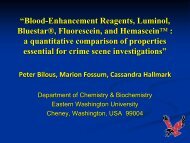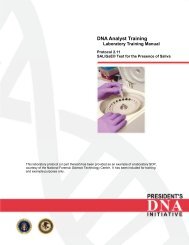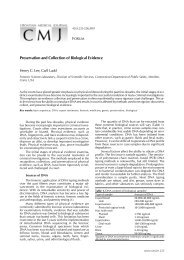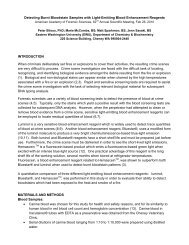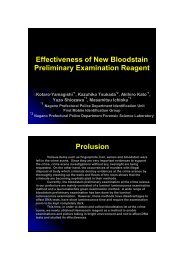Modern methods of collection and preservation of biological
Modern methods of collection and preservation of biological
Modern methods of collection and preservation of biological
You also want an ePaper? Increase the reach of your titles
YUMPU automatically turns print PDFs into web optimized ePapers that Google loves.
Evidence Possible Location <strong>of</strong> DNA on<br />
the Evidence<br />
Source <strong>of</strong> DNA<br />
baseball bat or similar<br />
H<strong>and</strong>le, end sweat, skin, blood,<br />
weapon<br />
tissue<br />
hat, b<strong>and</strong>anna, or<br />
mask<br />
Inside sweat, hair, d<strong>and</strong>ruff<br />
eyeglasses Nose or ear pieces, lens sweat, skin<br />
facial tissue, cotton<br />
Surface area mucus, blood, sweat,<br />
swab<br />
semen, ear wax<br />
dirty laundry Surface area blood, sweat, semen<br />
toothpick Tips saliva<br />
used cigarette Cigarette butt saliva<br />
stamp or envelope Licked area saliva<br />
tape or ligature Inside/outside surface skin, sweat<br />
bottle, can, or glass Sides, mouthpiece saliva, sweat<br />
used condom Inside/outside surface semen, vaginal or rectal<br />
cells<br />
blanket, pillow, sheet surface area sweat, hair, semen,<br />
urine, saliva<br />
“through <strong>and</strong><br />
through” bullet<br />
outside surface blood, tissue<br />
bite mark person’s skin or clothing saliva<br />
fingernail, partial<br />
fingernail<br />
Scrapings blood, sweat, tissue<br />
Table no. 1. DNA as evidence<br />
Note that, in practice, crime scenes samples may contain considerably less usable DNA<br />
depending on environmental conditions. DNA has been isolated from other sources, such as gastric<br />
fluids <strong>and</strong> fecal stains. However, it can be difficult to generate a DNA pr<strong>of</strong>ile from these sources in<br />
case samples due to significant degradation.<br />
Several factors affect the ability to obtain a DNA pr<strong>of</strong>ile. The sensitivity <strong>of</strong> PCR DNA<br />
typing <strong>methods</strong> is noteworthy, but still limited. The second concern is sample degradation.<br />
Prolonged exposure <strong>of</strong> even a large bloodstain to the environment or to bacterial contamination ca<br />
degrade the DNA <strong>and</strong> render it unsuitable for further analysis. The third consideration is sample<br />
purity <strong>and</strong> DNA content <strong>of</strong> different types <strong>of</strong> samples, as shown in table no.2.<br />
TYPE OF SAMPLE AMOUNT OF DNA<br />
liquid blood 20000-40000 ng/ml<br />
bloodstain 250-500 ng/cm 2<br />
liquid semen 150000-300000 ng/ml<br />
postcoital vaginal swab 10-3000 ng/swab<br />
plucked hair with root 1-750 ng/root<br />
shed hair with root 1-10 ng/root<br />
liquid saliva 1000-10000 ng/ml<br />
oral swab 100-1500 ng/swab<br />
urine 1-20 ng/ml<br />
bone 3-10 ng/mg<br />
tissue 50-500 ng/mg<br />
Table no.2. DNA content <strong>of</strong> <strong>biological</strong> samples



